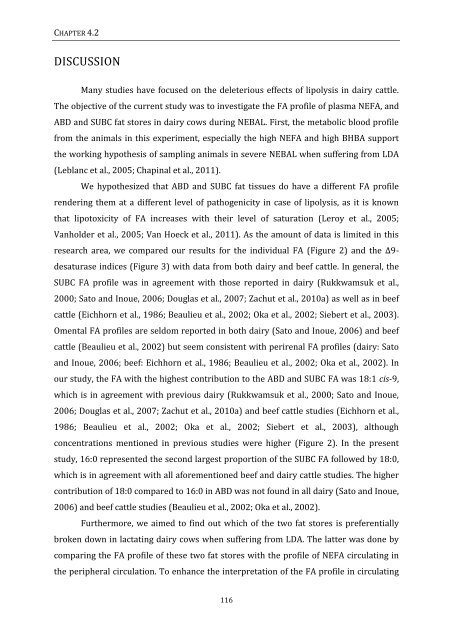view - Department of Reproduction, Obstetrics and Herd Health
view - Department of Reproduction, Obstetrics and Herd Health
view - Department of Reproduction, Obstetrics and Herd Health
Create successful ePaper yourself
Turn your PDF publications into a flip-book with our unique Google optimized e-Paper software.
CHAPTER 4.2<br />
DISCUSSION<br />
Many studies have focused on the deleterious effects <strong>of</strong> lipolysis in dairy cattle.<br />
The objective <strong>of</strong> the current study was to investigate the FA pr<strong>of</strong>ile <strong>of</strong> plasma NEFA, <strong>and</strong><br />
ABD <strong>and</strong> SUBC fat stores in dairy cows during NEBAL. First, the metabolic blood pr<strong>of</strong>ile<br />
from the animals in this experiment, especially the high NEFA <strong>and</strong> high BHBA support<br />
the working hypothesis <strong>of</strong> sampling animals in severe NEBAL when suffering from LDA<br />
(Leblanc et al., 2005; Chapinal et al., 2011).<br />
We hypothesized that ABD <strong>and</strong> SUBC fat tissues do have a different FA pr<strong>of</strong>ile<br />
rendering them at a different level <strong>of</strong> pathogenicity in case <strong>of</strong> lipolysis, as it is known<br />
that lipotoxicity <strong>of</strong> FA increases with their level <strong>of</strong> saturation (Leroy et al., 2005;<br />
Vanholder et al., 2005; Van Hoeck et al., 2011). As the amount <strong>of</strong> data is limited in this<br />
research area, we compared our results for the individual FA (Figure 2) <strong>and</strong> the ∆9-<br />
desaturase indices (Figure 3) with data from both dairy <strong>and</strong> beef cattle. In general, the<br />
SUBC FA pr<strong>of</strong>ile was in agreement with those reported in dairy (Rukkwamsuk et al.,<br />
2000; Sato <strong>and</strong> Inoue, 2006; Douglas et al., 2007; Zachut et al., 2010a) as well as in beef<br />
cattle (Eichhorn et al., 1986; Beaulieu et al., 2002; Oka et al., 2002; Siebert et al., 2003).<br />
Omental FA pr<strong>of</strong>iles are seldom reported in both dairy (Sato <strong>and</strong> Inoue, 2006) <strong>and</strong> beef<br />
cattle (Beaulieu et al., 2002) but seem consistent with perirenal FA pr<strong>of</strong>iles (dairy: Sato<br />
<strong>and</strong> Inoue, 2006; beef: Eichhorn et al., 1986; Beaulieu et al., 2002; Oka et al., 2002). In<br />
our study, the FA with the highest contribution to the ABD <strong>and</strong> SUBC FA was 18:1 cis-9,<br />
which is in agreement with previous dairy (Rukkwamsuk et al., 2000; Sato <strong>and</strong> Inoue,<br />
2006; Douglas et al., 2007; Zachut et al., 2010a) <strong>and</strong> beef cattle studies (Eichhorn et al.,<br />
1986; Beaulieu et al., 2002; Oka et al., 2002; Siebert et al., 2003), although<br />
concentrations mentioned in previous studies were higher (Figure 2). In the present<br />
study, 16:0 represented the second largest proportion <strong>of</strong> the SUBC FA followed by 18:0,<br />
which is in agreement with all aforementioned beef <strong>and</strong> dairy cattle studies. The higher<br />
contribution <strong>of</strong> 18:0 compared to 16:0 in ABD was not found in all dairy (Sato <strong>and</strong> Inoue,<br />
2006) <strong>and</strong> beef cattle studies (Beaulieu et al., 2002; Oka et al., 2002).<br />
Furthermore, we aimed to find out which <strong>of</strong> the two fat stores is preferentially<br />
broken down in lactating dairy cows when suffering from LDA. The latter was done by<br />
comparing the FA pr<strong>of</strong>ile <strong>of</strong> these two fat stores with the pr<strong>of</strong>ile <strong>of</strong> NEFA circulating in<br />
the peripheral circulation. To enhance the interpretation <strong>of</strong> the FA pr<strong>of</strong>ile in circulating<br />
116









